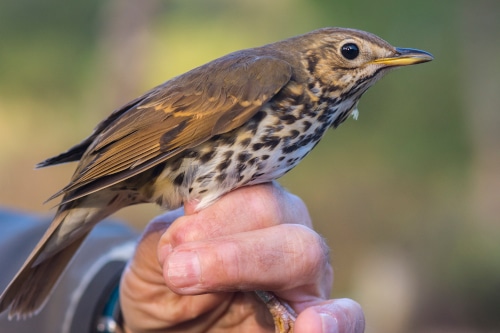A co-authored paper was just published in Oikos: “Assessing short- and long-term variations in diversity, timing and body condition of migratory frugivorous birds?”
Early January we published a new paper where we look at changes in the diversity (composition and abundance), phenological timing and body condition of the community of frugivorous birds in Doñana, SW Spain. In this study, we evaluated changes at long (~40 years) and short-time (seasonal) spans in an avian frugivore community using a snapshot resampling. This was the MSc thesis of María Campo Celada, masterfully supervised by Irene Mendoza and Pedro Jordano, two of my colleagues at EBD. I was involved as advisor and collaborated in some of the fieldwork, which was really nice because I had not captured birds with mistnets since early 2010s! We were also helped by many volunteers and, of course, our official bird ringers and co-authors, Carlos Gutiérrez-Expósito and Julio Rabadán. The interesting part of this study is that we had two sampling periods separated by 40 years. Basically we replicated the sampling methods used by Pedro Jordano during his PhD in order to understand how the community of frugivorous birds had changed since the 1980s. This was an unprecedented opportunity to understand long-term changes in the diversity (composition and abundance), phenological timing and body condition of frugivorous birds in Hato Ratón, a Mediterranean scrubland site increasingly encroached by pines which have replaced flesy-fruited shrubs. Our findings indicate a profound transformation of species composition, bird phenology and body condition: in ~40 years, the avian community showed a 66% and 18.4% decrease of the abundance of wintering and seed-disperser species, respectively. Additionally, seasonal abundance peaks were advanced for at least one month in the 9 out of 11 frugivorous bird species included in the analyses, and avian body condition during the migratory passage had worsened. Finally, we report a fruit production decrease of almost half in 2019–2021 compared to 1981–1983, probably linked to habitat encroachment by pine trees and replacement of fleshy-fruited shrubs. We speculate that vegetation encroachment and climate change are the most plausible explanations for the observed changes in the avian community, but with our current data we cannot fully conclude which of these factors is a key driver of the reported changes, and whether there are other factors involved. Overall, our results from a local site mirror the dramatic consequences of global change affecting the diversity, phenology and physical condition of frugivorous bird species reported in multiple studies across the globe, which may have cascading effects on the regeneration of fleshy-fruited plant communities.
Campo-Celada, M., Jordano, P. , Benítez-López, A., Gutiérrez-Expósito, C., Rabadán-González, J., Mendoza, I. (2022) Assessing short- and long-term variations in diversity, timing and body condition of migratory frugivorous birds. Oikos. doi: 10.1111/oik.08387
